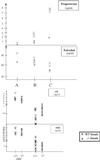Alpha-fetoprotein, the major fetal serum protein, is not essential for embryonic development but is required for female fertility
- PMID: 12297623
- PMCID: PMC130551
- DOI: 10.1073/pnas.202215399
Alpha-fetoprotein, the major fetal serum protein, is not essential for embryonic development but is required for female fertility
Abstract
The alpha-fetoprotein gene (Afp) is a member of a multigenic family that comprises the related genes encoding albumin, alpha-albumin, and vitamin D binding protein. The biological role of this major embryonic serum protein is unknown although numerous speculations have been made. We have used gene targeting to show that AFP is not required for embryonic development. AFP null embryos develop normally, and individually transplanted homozygous embryos can develop in an AFP-deficient microenvironment. Whereas mutant homozygous adult males are viable and fertile, AFP null females are infertile. Our analyses of these mice indicate that the defect is caused by a dysfunction of the hypothalamic/pituitary system, leading to anovulation.
Figures






Similar articles
-
Deficiency of reproductive tract alpha(1,2)fucosylated glycans and normal fertility in mice with targeted deletions of the FUT1 or FUT2 alpha(1,2)fucosyltransferase locus.Mol Cell Biol. 2001 Dec;21(24):8336-45. doi: 10.1128/MCB.21.24.8336-8345.2001. Mol Cell Biol. 2001. PMID: 11713270 Free PMC article.
-
Alpha-fetoprotein controls female fertility and prenatal development of the gonadotropin-releasing hormone pathway through an antiestrogenic action.Mol Cell Biol. 2006 Mar;26(5):2012-8. doi: 10.1128/MCB.26.5.2012-2018.2006. Mol Cell Biol. 2006. PMID: 16479017 Free PMC article.
-
Mice homozygous for a null mutation of activin beta B are viable and fertile.Mech Dev. 1994 Jul;47(1):43-51. doi: 10.1016/0925-4773(94)90094-9. Mech Dev. 1994. PMID: 7947320
-
Structural and functional mapping of alpha-fetoprotein.Biochemistry (Mosc). 2006 Feb;71(2):120-32. doi: 10.1134/s0006297906020027. Biochemistry (Mosc). 2006. PMID: 16489915 Review.
-
Alpha-fetoprotein, a fascinating protein and biomarker in neurology.Eur J Paediatr Neurol. 2014 May;18(3):243-8. doi: 10.1016/j.ejpn.2013.09.003. Epub 2013 Sep 29. Eur J Paediatr Neurol. 2014. PMID: 24120489 Review.
Cited by
-
Alpha-fetoprotein: from a diagnostic biomarker to a key role in female fertility.Biomark Insights. 2007 Feb 7;1:82-5. Biomark Insights. 2007. PMID: 19690639 Free PMC article.
-
Alpha-fetoprotein stimulated the expression of some oncogenes in human hepatocellular carcinoma Bel 7402 cells.World J Gastroenterol. 2004 Mar 15;10(6):819-24. doi: 10.3748/wjg.v10.i6.819. World J Gastroenterol. 2004. PMID: 15040024 Free PMC article.
-
Alpha-fetoprotein related gene (ARG): a new member of the albumin gene family that is no longer functional in primates.Gene. 2010 Jan 1;449(1-2):95-102. doi: 10.1016/j.gene.2009.08.014. Epub 2009 Sep 3. Gene. 2010. PMID: 19733224 Free PMC article.
-
Alpha-fetoprotein triggers hepatoma cells escaping from immune surveillance through altering the expression of Fas/FasL and tumor necrosis factor related apoptosis-inducing ligand and its receptor of lymphocytes and liver cancer cells.World J Gastroenterol. 2005 May 7;11(17):2564-9. doi: 10.3748/wjg.v11.i17.2564. World J Gastroenterol. 2005. PMID: 15849812 Free PMC article.
-
Alpha-fetoprotein, identified as a novel marker for the antioxidant effect of placental extract, exhibits synergistic antioxidant activity in the presence of estradiol.PLoS One. 2014 Jun 12;9(6):e99421. doi: 10.1371/journal.pone.0099421. eCollection 2014. PLoS One. 2014. PMID: 24922551 Free PMC article.
References
-
- Andrews G K, Dziadek M, Tamaoki T. J Biol Chem. 1982;257:5148–5153. - PubMed
-
- Leighton P C, Kitau M J, Chard T, Gordon Y B, Leek A E. Lancet. 1975;7943:1012–1015. - PubMed
-
- Cuckle H S, Wald N J, Lindenbaum R H. Lancet. 1984;8383:926–929. - PubMed
-
- Tilghman S M. In: Oxford Survey on Eukaryotic Genes. Maclean N, editor. Oxford: Oxford Univ. Press; 1985. pp. 160–206. - PubMed
Publication types
MeSH terms
Substances
LinkOut - more resources
Full Text Sources
Molecular Biology Databases

